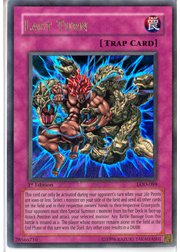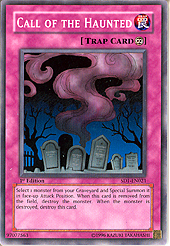“The two great spirits locked eyes. This would indeed be their final battle.”—Kozaky
 The month of June brought several changes to the Yu-Gi-Oh! TCG. Many of these changes altered the way we play, bringing more strategy and a deeper understanding to the game. June also brought us detailed rulings for some cards that had long been an enigma. Cards like Last Turn and Mirror Wall have been a source of problems for duelists and judges alike, and obtaining detailed rulings was quite an achievement.
The month of June brought several changes to the Yu-Gi-Oh! TCG. Many of these changes altered the way we play, bringing more strategy and a deeper understanding to the game. June also brought us detailed rulings for some cards that had long been an enigma. Cards like Last Turn and Mirror Wall have been a source of problems for duelists and judges alike, and obtaining detailed rulings was quite an achievement.
For the next few weeks, we will cover rulings clarifications in the game and examine cards that have been given full rulings detail. I think it’s best to start with one of the most well-known of these cards, and that’s Last Turn.
When Legends Collide
Last Turn is part of a rare collection of cards that are capable of creating alternate win conditions. The player using Last Turn intends to win the game by using this card and foregoing the standard methods of life point depletion. In order to do so, the player must meet a strict life point requirement and control the best possible monster. The setup and successful execution of Last Turn is tricky, and any misstep can lead to disastrous results.
Last Turn’s most recent text:
“This card can only be activated during your opponent's turn when your Life Points are 1000 or less. Select 1 monster on your side of the field and send all other cards on the field and in their respective owners' hands to their respective Graveyards. After that, your opponent selects and Special Summons 1 monster from their Deck in face-up Attack Position and attacks your selected monster. (Any Battle Damage from this battle is treated as 0.) The player whose monster remains alone on the field at the End Phase of this turn wins the Duel. Any other case results in a DRAW.”
That is a lot of text, isn’t it? Last Turn is certainly a card that makes you think. But don’t worry—when we split the text up into segments, it will make much more sense.
“This card can only be activated during your opponent’s turn when your Life Points are 1000 or less.”
 This condition can be met in many ways, but one of the most popular methods involves using Wall of Revealing Light to quickly drop your life points. Normally, a player will activate Wall of Revealing Light and spend the thousands of life points necessary to drop his or her life point total to 1000 or less. After doing this, the player then activates Last Turn. Obviously, this must be done during the opponent’s turn, as that’s what Last Turn’s activation condition demands.
This condition can be met in many ways, but one of the most popular methods involves using Wall of Revealing Light to quickly drop your life points. Normally, a player will activate Wall of Revealing Light and spend the thousands of life points necessary to drop his or her life point total to 1000 or less. After doing this, the player then activates Last Turn. Obviously, this must be done during the opponent’s turn, as that’s what Last Turn’s activation condition demands.
Some players also like to use cards with heavy life point payments, like Solemn Judgment, or cards with self-inflicted damage penalties, like Graverobber. While these strategies are not as quick as using Wall of Revealing Light, they do allow for a Last Turn deck to have a longer-term plan.
“Select 1 monster on your side of the field and send all other cards on the field and in their respective owners' hands to their respective Graveyards.”
It is important to note here that Last Turn’s effect does not target. I cannot emphasize this enough. This makes monsters like Spirit Reaper and Tyrant Dragon acceptable candidates for the Last Turn cage-match. It also means that your opponent has no idea what monster you will use for Last Turn when you activate it. If you have multiple monsters on your side of the field, any one of them could become your champion.
Example: The champion is . . .
Grace has three monsters on her side of the field: Guardian Angel Joan, , and Spirit Reaper. She is holding on at 800 life points, but she has Last Turn set on the field and intends to use it. Her opponent Jack begins his turn. Grace activates her set Last Turn. Jack chains his set Compulsory Evacuation Device, targeting her Guardian Angel Joan.
When the chain resolves, Guardian Angel Joan will be bounced back into Grace’s hand. Then her Last Turn resolves, and she will choose to use either D. D. Warrior Lady or Spirit Reaper as her champion.
Jack had to place his gamble and chose to remove the monster he felt would be the worst to face off against. Because Grace had more than one monster, his plan only helped to soften the blow instead of to defeat it entirely.
After the champion monster is chosen, every other card on the field and in both players’ hands are sent to the graveyard. This clears off the table and sets the stage for the great battle between monsters. This act of clearing also has its own interactions.
The phrase “sent to the graveyard” is an important one. It will impact many other cards when Last Turn finally resolves. Cards with effects that contain the words “discard” or “destroy” will not be influenced by the effect of Last Turn.
 Call of the Haunted says it will destroy the monster that it special summoned when the trap card is removed from the field. Last Turn will remove Call of the Haunted from the field and the penalty will be applied, destroying the special summoned monster. It’s not wise to choose a monster that’s attached to Call of the Haunted as your champion.
Call of the Haunted says it will destroy the monster that it special summoned when the trap card is removed from the field. Last Turn will remove Call of the Haunted from the field and the penalty will be applied, destroying the special summoned monster. It’s not wise to choose a monster that’s attached to Call of the Haunted as your champion.
However, the interaction between Last Turn and Premature Burial is quite different. Premature Burial can be “sent to the graveyard” without any harm coming to the equipped monster. This is because Premature Burial only cares about itself being destroyed. Simply being “sent to the graveyard” by Last Turn is not a problem.
In my previous article about Toon monsters, like Blue-Eyes Toon Dragon, I mentioned that Toon monsters don’t care if Toon World is simply “sent to the graveyard.” They only care if Toon World is destroyed. This means that Last Turn can be used with Toon monsters without suffering any major setbacks.
Some monsters have effects that actively seek out this “sent to the graveyard” event. Monsters like Night Assailant, Regenerating Mummy, and Despair from the Dark will have their effects activated as a result of Last Turn, so you need to be wary if they’re in your opponent’s hand.
If your opponent has Sangan on his or her side of the field and it is sent to the graveyard by the clearing effect of Last Turn, its effect will also activate. This will allow your opponent to search the deck for a monster that can be normal summoned during his or her main phase.
After the field-clearing has been completed, Last Turn’s effect has finished resolving. Everything else that happens from this point forward will occur after Last Turn’s resolution. The effects of cards activated by the clearing will now begin a new chain. It is possible to respond to this chain—however, you probably won’t have any cards that you can use to respond.
Sometimes Last Turn will find itself without a monster when it resolves. This can easily happen when the turn player uses an effect like Brain Control and targets the only monster that the Last Turn player has under his or her control. If the Last Turn player chooses to activate Last Turn as part of a chain, Last Turn will attempt to resolve as best it can. After the clearing effect, the turn player will take control of the monster and then continue with the effects of Last Turn, including the special summon.
What about the special summon? Well . . . that’s another story entirely. Not all of Last Turn’s effects are applied when it resolves. Its remaining effects are applied afterwards, which is similar to cards like Change of Heart and Last Will.
Next week, we will continue our analysis of Last Turn. We will cover the opponent special summoning his or her monster and the great battle between the two champion monsters. Be sure to come back next week.
Send all comments to Curtis @ metagame.com.